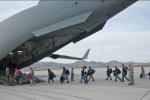A supercomputer at Los Alamos National Laboratory is helping scientists understand how a nuclear detonation might affect an incoming, Earth-threatening asteroid. View the entire Lab Breakthrough playlist.
Los Alamos National Laboratory’s Bob Weaver took some time recently to talk about how his research would help avert a catastrophic asteroid impact; saving the world from complete destruction and rescuing humans from mass extinction.
This Q&A and video are part of the Lab Breakthrough series, which highlights innovations developed at the National Labs.
Question: What is the usual reaction from people when you tell them what you do?
Bob Weaver: The usual reaction is one of encouragement. I find that people are fascinated with this topic of using nuclear explosions to divert potentially hazardous objects from hitting the earth. There seems to be a lot of misconceptions in the general public as well.
Many times I get asked: "If you blow up the asteroid won't there be an even greater threat from all the pieces then hitting the Earth?" The correct answer is that this depends on how long one has before the original object would hit the Earth.
If time is very short (say less than a month), than there is probably nothing mankind can do. However if the nuclear intercept is far enough away from the Earth and strong enough (say, 1 megaton for an object 500 meters wide) then our simulations show that the asteroid fragments will not re-collect under their own gravity, sending the pieces into non-Earth crossing orbits.
Q: To be clear, how would this technology work in terms of an object on a collision course with Earth. First, another facility might notice a near-Earth object, such as an asteroid, might impact us. Would someone then call you to see how to destroy the object?
BW: I am flattered that someone might consider calling me in the case of a potentially worldwide catastrophe.
The truth to how any intercept mission will be planned is being worked at the international level. One such venue that people can see on the Internet is the Planetary Defense Conference, which is held every two years.
My work on computer modeling of potential intercepts is just one of many methods being considered by the community. My hope is that through the results of these simulations and others around the world, that we can give more detailed, internationally vetted solutions to the world leaders who would be responsible to coordinate an intercept mission.
Q: It's scary that we are even thinking about this concept. What are the chances an asteroid will actually hit earth?
BW: There is an active program from NASA to observe the asteroids and comets in our solar system, and then determine their orbits, mass and any potential hazard. We have a good idea of where most objects greater than 100 meters are. Objects smaller, though, could be very dangerous to regional areas directly under the impact, but not a worldwide catastrophe.
The real threat is probably not from any known or unknown asteroid, but rather from an unknown comet. Many comets have highly elliptical orbits around the sun. These comets may not be visible from Earth because they are so far away for most of their orbit. If one of these unknown comets is big enough and traveling fast enough, we may not discover it until very late. My work will evolve to studying comets as well as porous asteroids as we have more resources to perform these large computer simulations.
Q: Was this technology built in response to any particular incident or near-miss? If not, then where did the curiosity begin?
BW: The potential for a catastrophic event is not new. The 10-kilometer asteroid that hit Chicxulub, Mexico, at the K-T geologic boundary shows us that worldwide devastation is possible. This event is thought to have worldwide consequences such as mass extinctions including all the dinosaurs.
The more recent Tunguska event over Russia in 1908 is another example of a smaller object that caused extreme regional damage. The estimated size of the Tunguska object is tens of meters across, though it leveled about 800 square miles of forest with a blast about 1,000 times greater than the first atomic bombs.
Both of these events occurred before any technical means existed to realize a threat would occur. What is new is the ability to use our fastest supercomputers with highly developed physics codes to better understand how we might want to mitigate any hazardous object should we find one.
Q: What about your facilities specific resources made it the right place to develop this technology?
BW: At Los Alamos National Laboratory we have been developing massively parallel computer codes to calculate complex hydrodynamic problems on the world's faster supercomputers. Many years of work go into the production and validation of these computer codes. So we are truly positioned at the right place to study these complex interactions.
However, Los Alamos is not unique in this manner, other national Labs as well as academic institutions have the codes and computer power to join in on these mitigation simulations. Our goal is to provide the world's leadership with options that have been peer-reviewed by the scientific community to help mitigate a future potentially hazardous object from causing damage on Earth.
Visit the Lab Breakthroughs topic page for the most recent breakthroughs highlighted in the video series.





